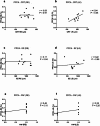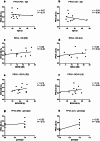Analysis of choriocapillaris vascular density in patients with retinitis pigmentosa caused by RPGR gene mutations
- PMID: 40597960
- PMCID: PMC12211357
- DOI: 10.1186/s12886-025-04163-z
Analysis of choriocapillaris vascular density in patients with retinitis pigmentosa caused by RPGR gene mutations
Abstract
Background: Anatomic features characterizing the onset and progression of Retinitis Pigmentosa (RP) are still not clear and increasing interest has grown towards the impaired retinal flow in such disease. However, to date there are still few and inconsistent data exploring the changes reflected in vascular plexuses during the disease course, in particular regarding Choriocapillaris (CC). Therefore, the purpose of this study aimed at evaluating the CC perfusion in a cohort of males with RPGR-related X-Linked RP (XLRP).
Methods: Best corrected visual acuity (BCVA), color fundus photograph, fundus autofluorescence (FAF), optical coherence tomography (OCT), OCT-angiography (OCTA) and microperimetry (MP) were performed in 13 XLRP patients (22 eyes) harboring mutations in RPGR. The percent perfused CC area (PPCA) was analyzed and correlated with the phenotypic variables and mutation location. Moreover, the PPCA of RPGR-related XLRP patients was compared with age-matched healthy controls.
Results: The PPCA of the cases was 25.4% ± 7.5%, while controls displayed a PPCA of 32.3% ± 6.1% (p < 0.002). Moreover, PPCA appeared to be not significantly correlated with any of the anatomical and functional parameters analyzed, nor with the age of the patients, the duration of the disease and with the genotype.
Conclusions: The PPCA resulted significantly reduced in patients with RPGR-related XLRP when compared to age-matched healthy controls.
Keywords: RPRG-related X-Linked retinitis pigmentosa; Choriocapillaris; Percent perfused choriocapillaris area.
Conflict of interest statement
Declarations. Ethics approval and consent to participate: This study complied with the tenets of the Declaration of Helsinki and was approved by the Institutional Review Board of the University of Campania “Luigi Vanvitelli”. Additionally, all patients signed an informed consent for participation in the study. Consent for publication: Not applicable. Competing interests: The authors declare no competing interests.
Figures






Similar articles
-
Mutations in the X-linked retinitis pigmentosa genes RPGR and RP2 found in 8.5% of families with a provisional diagnosis of autosomal dominant retinitis pigmentosa.Invest Ophthalmol Vis Sci. 2013 Feb 19;54(2):1411-6. doi: 10.1167/iovs.12-11541. Invest Ophthalmol Vis Sci. 2013. PMID: 23372056 Free PMC article.
-
Disease course of patients with X-linked retinitis pigmentosa due to RPGR gene mutations.Invest Ophthalmol Vis Sci. 2007 Mar;48(3):1298-304. doi: 10.1167/iovs.06-0971. Invest Ophthalmol Vis Sci. 2007. PMID: 17325176
-
Phenotypes in three Swedish families with X-linked retinitis pigmentosa caused by different mutations in the RPGR gene.Am J Ophthalmol. 1997 Jul;124(1):95-102. doi: 10.1016/s0002-9394(14)71649-6. Am J Ophthalmol. 1997. PMID: 9222238
-
Multiprotein complexes of Retinitis Pigmentosa GTPase regulator (RPGR), a ciliary protein mutated in X-linked Retinitis Pigmentosa (XLRP).Adv Exp Med Biol. 2010;664:105-14. doi: 10.1007/978-1-4419-1399-9_13. Adv Exp Med Biol. 2010. PMID: 20238008 Free PMC article. Review.
-
Mutations of RPGR in X-linked retinitis pigmentosa (RP3).Hum Mutat. 2002 May;19(5):486-500. doi: 10.1002/humu.10057. Hum Mutat. 2002. PMID: 11968081 Review.
References
-
- Hartong DT, Berson EL, Dryja TP. Retinitis pigmentosa. Lancet. 2006;368:1795–809. - PubMed
-
- Verbakel SK, van Huet RAC, Boon CJF, den Hollander AI, Collin RWJ, Klaver CCW, et al. Non-syndromic retinitis pigmentosa. Prog Retin Eye Res. 2018;66:157–86. - PubMed
-
- Tee JJL, Smith AJ, Hardcastle AJ, Michaelides M. RPGR-associated retinopathy: clinical features, molecular genetics, animal models and therapeutic options. Br J Ophthalmol. 2016;100:1022–7. - PubMed
-
- Talib M, Van Schooneveld MJ, Thiadens AA, Fiocco M, Wijnholds J, Florijn RJ, et al. Clinical and genetic characteristics of male patients with rpgr-associated retinal dystrophies: A Long-Term Follow-up study. Retina. 2019;39:1186–9. - PubMed
LinkOut - more resources
Full Text Sources

